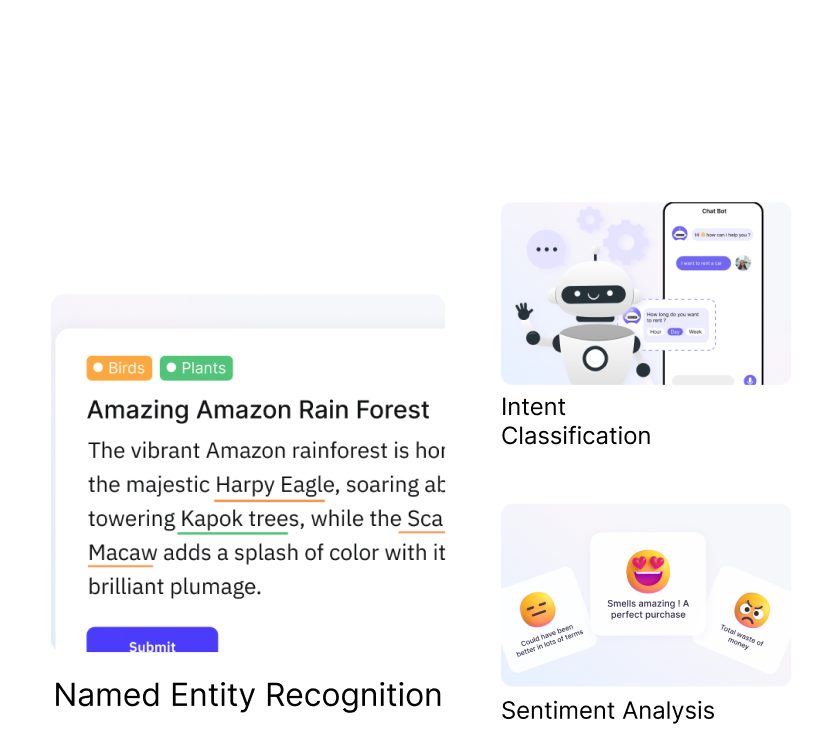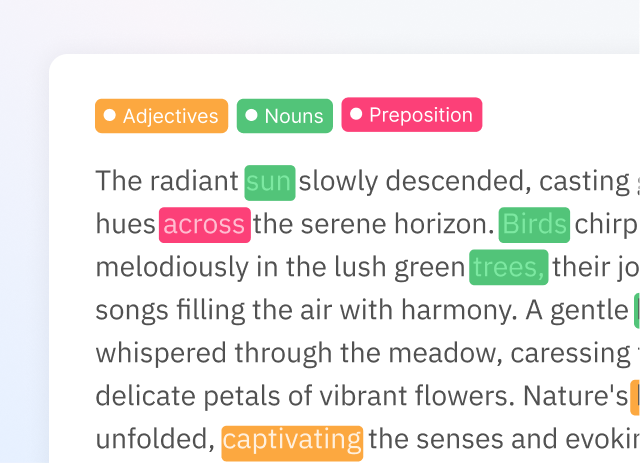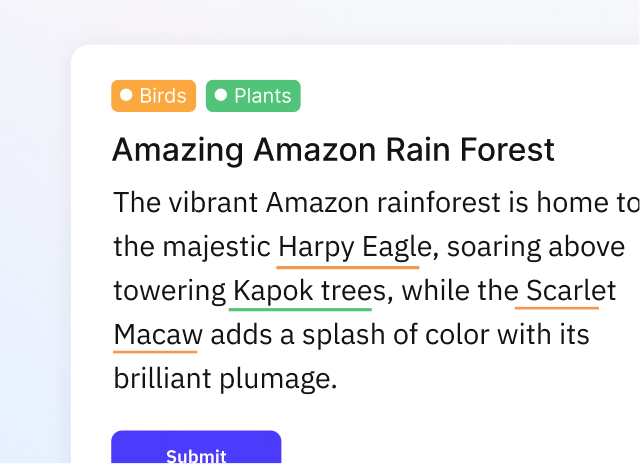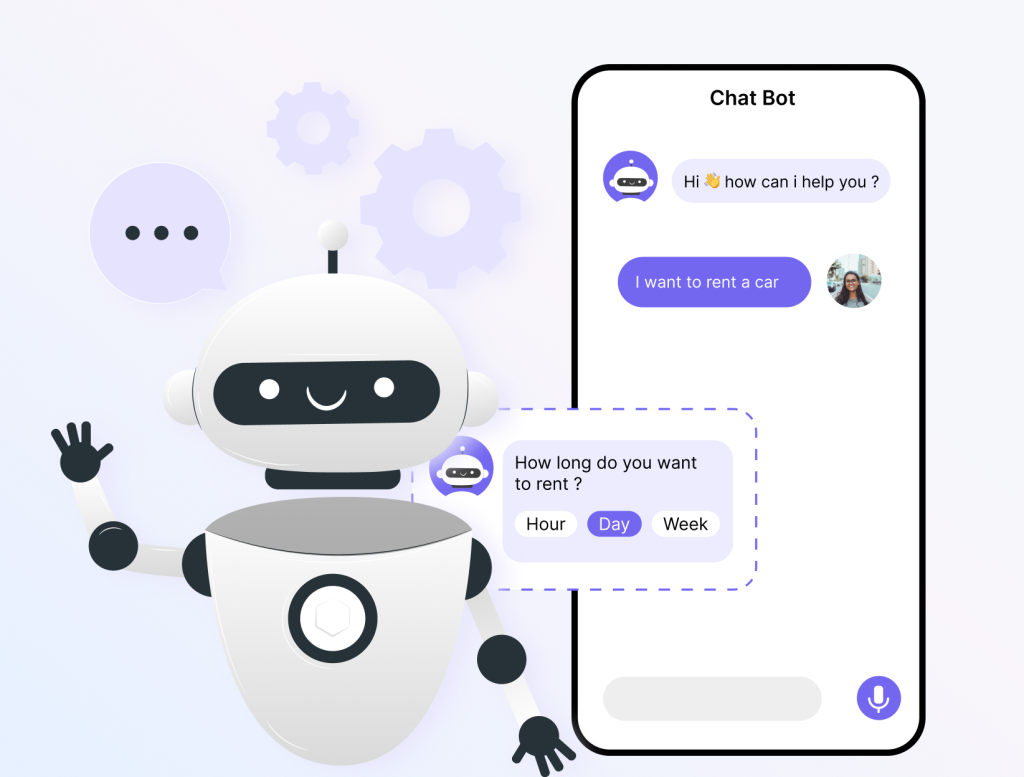Text Annotation/ NLP Annotation
Text/NLP annotation involves adding metadata, labels, or tags to text data for better analysis by NLP models. Human annotators annotate text and review, label, or tag it based on guidelines. It trains NLP models by providing labeled data to learn patterns and relationships. Text annotation is essential for improving NLP models’ understanding of text.


Sentiment analysis
Text annotation can be used to label text data with sentiment categories such as positive, negative, or neutral. This is useful for analyzing customer reviews, social media comments, or any other form of text to understand the sentiment expressed.
Use Cases
- Social media monitoring to track and analyze public sentiment towards brands, products, events, or social issues.
- Monitor and analyze sentiment towards a brand and its competitors.
- Financial markets analyze sentiment from news articles, social media, or financial reports.
- Brand reputation management by monitoring sentiment towards a brand across various online platforms.
- Enables businesses to analyze views towards specific product features or aspects.

Part-of-speech (POS) tagging
POS tagging involves labeling words in a text with their respective parts of speech, such as nouns, verbs, adjectives, and adverbs. This annotation helps in syntactic analysis, grammar checking, and improving the accuracy of natural language processing tasks.
Use Cases
- Syntactic analysis by providing grammatical information about words in a sentence.
- Allowing more precise query formulation and search.
- Machine translation by providing linguistic information
- Assists in sentiment analysis by providing insights
- Preprocessing step in Named Entity Recognition tasks.

Named entity recognition
NER involves identifying and categorizing named entities within the text, such as names of people, organizations, locations, dates, and other specific entities. Text annotation can be used to label these entities, which is valuable in information extraction, search, and natural language processing applications.
Use Cases
- Assists in document understanding and summarization by identifying key entities within the text.
- Enhances search and information retrieval systems by identifying and categorizing entities within documents or web pages.
- Applied in social media monitoring to extract and categorize entities from social media posts or comments.
- Assists in question-answering systems by identifying relevant entities mentioned in the questions or within the text corpus.

Intent classification
Text annotation can be used to categorize text into specific intent classes, such as identifying if a customer query is related to sales, support, or billing. This is particularly useful in chatbot development, customer support automation, and routing customer inquiries to the appropriate departments.
Use Cases
- Accurately understand user queries and respond accordingly.
- Understanding user intent during online shopping experiences.
- Fraud detection and security systems to identify potentially fraudulent or malicious user intentions.
- Applied in market research to categorize and analyze customer feedback, survey responses, or social media posts.
- Used in voice assistants for smart devices, such as smart speakers or smart TVs.

Text categorization
Annotation can be used to classify text into predefined categories or labels, such as classifying news articles into politics, sports, entertainment, or technology. This aids in information retrieval, content organization, and content-based filtering.
Use Cases
- Helps in organizing large volumes of text documents by categorizing them into specific topics, subjects, or themes.
- Content filtering and moderation tasks to categorize user-generated content. Aids in personalized news recommendations.
- Aids in personalized news recommendations.
- Filtering out unwanted or unsolicited messages, and ensuring inbox security.
- Multilingual applications, translation services, and content localization.
- Understanding customer preferences.

Topic classification
Annotation can be applied to text documents to categorize them into predefined topics or themes. This is beneficial in content organization, news classification, document filtering, and personalized recommendation systems.
Use Cases
- Organizing large volumes of textual data by categorizing documents into specific topics or subjects.
- Enables personalized news recommendations based on user preferences Categories feedback into different topics.
- Aids in understanding market trends.
- Routes emails to the relevant teams or individuals, and improves response times.
- Used in voice assistants for smart devices, such as smart speakers or smart TVs.
Ready to Get Started ? We Are
We’d love the opportunity to answer your questions or learn more about your project. Let us know how can we help

